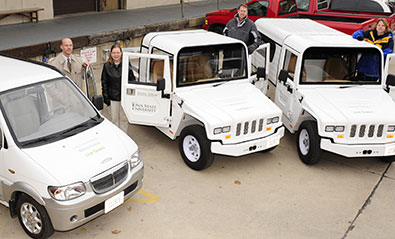Inside Iowa State
Inside ArchivesSubmit newsSend news for Inside to inside@iastate.edu, or call (515) 294-7065. See publication dates, deadlines. About InsideInside Iowa State, a newspaper for faculty and staff, is published by the Office of University Relations. |
Nov. 21, 2008 
President Gregory Geoffroy test drives one of the university's four new electric vehicles, the Miles four-passenger car being used in FP&M. Photo by Bob Elbert. Electric vehicles arrive on campusby Anne Krapfl Perhaps you've seen them. Or heard about them. But unlike other vehicles in the university fleet, it's doubtful that you've heard them. Four electric vehicles are being delivered to campus this fall: a car and a utility vehicle each for environmental health and safety, and facilities planning and management. They're small, quiet and best of all, lack gas tanks. "The only way to know if they'll work here is to try them," said Bill Diesslin, assistant director of EH&S. "This is a response to president Geoffroy's directive that the university will try energy alternatives. "Our job is to demonstrate the technology and offer the opportunity to others to try it," he said. The four vehicles come from three different manufacturers of electric vehicles -- eRide Industries, ZENN and Miles -- again, to have a good sample to use and evaluate. "We'd like to continue to 'green' the fleet," said Kathy Wellik, manager of transportation services, who also was involved in test-driving electric vehicles and working with the purchasing department to develop the bid. The 450-vehicle fleet that Wellik's group takes care of includes six hybrid vehicles -- one Toyota Prius available for daily use and five Ford Escapes, all on yearly leases to departments. She is looking to expand that line as well. Transportation services leases two of the electric vehicles to EH&S; FP&M purchased its own electric vehicles. What can they do?The four electric vehicles Iowa State purchased run on a battery combination of 72 volts, either nine 8-volt batteries or six 12-volt batteries. The vehicles cost $15,000 to $25,000 apiece. Top speed is 25 miles per hour and the traveling range is about 50 miles before the battery system has to be recharged. Diesslin points out that the speed limit on most campus roads is 25 mph, "but how often are you actually going that fast?" he said. He also noted that EH&S staff average 20 to 25 campus miles per day in their vehicles. "We asked ourselves, will this meet 100 percent of our [transportation] needs?" Diesslin said. "The answer was 'no.' It won't get us to Des Moines, for example. Will it meet 80 percent of our needs? We think so, and that's what we'd like to find out." EH&S' utility truck, which seats two and has an enclosed truck bed, replaces an older minivan. EH&S staff use it daily to service fire extinguishers all over campus. FP&M's utility vehicle also seats two people but has an open cargo area. FP&M assistant director Bob Currie said it's being used much as a pickup truck, to transport staff, supplies and materials for building or grounds maintenance. The FP&M car seats four and has a small cargo area. The EH&S car seats two and, while department staff will use it to get to remote corners of campus, Diesslin secretly hopes it's not available much for them. Any campus units that see possibilities for using electric vehicles in their operations are encouraged to contact Diesslin. "If someone thinks they have an application for an electric vehicle, they should call me at 4-2105 to try it," he said. Are they for real?Wellik, Currie and Diesslin all agree: The purchases have been made, and now the real work begins to assess whether electric cars are a viable option at Iowa State. How do they handle on snow and ice? Do they start at 10 degrees below zero? Are they a nuisance to maintain? Do staff want to use them? Do they hold up well over time? How much electricity does it take each month to keep the batteries charged? What is that costing us? These are all questions to be answered in the months ahead. "Electric vehicles don't eliminate the need for combustion-engine vehicles," Diesslin noted. "But we need to try the technology and make it available to others to try." 
Some of the staff involved in selecting the electric vehicles the university opted to purchase are (l-r): Bill Diesslin, environmental health and safety; Kathy Wellik, transportation services; Bob Currie, facilities planning and management; and Wendy Foster, purchasing. Three of the four electric vehicles also are pictured. EH&S is waiting on delivery of a ZENN two-passenger car. Photo by Bob Elbert. |
Quote"The only way to know if they'll work here is to try them . . . Our job is to demonstrate the technology and offer the opportunity to others to try it." -- Bill Diesslin |